Berg Estuary Ramsar Site
Berg Estuary Ramsar Site
- Country:
- South Africa
- Site number:
- 2466
- Area:
- 1,162.9 ha
- Designation date:
- 01-02-2022
- Coordinates:
- 32°51'15"S 18°15'27"E
Carousel
CarouselMaterials presented on this website, particularly maps and territorial information, are as-is and as-available based on available data and do not imply the expression of any opinion whatsoever on the part of the Secretariat of the Ramsar Convention concerning the legal status of any country, territory, city or area, or of its authorities, or concerning the delimitation of its frontiers or boundaries.
The Berg River Estuary follows the lower stretch of the River and is one of four perennial estuaries on the west coast of Southern Africa. The Estuary is one of the most important coastal wetlands in South Africa. Fresh water flowing from the estuary and its floodplain mixes with marine water, enabling diverse conditions for various habitats to flourish. Among these is the third-largest saltmarsh on the Cape Coast. The Site’s unique vegetation is a valuable natural asset because of its rare plant species which are typical of the wider region, such as waterblommetjie (Aponogeton distachyos), soutbos (Bassia diffusa), sareegras (Bolboschoenus maritimus), ruppia (Ruppia cirrhosa) and the vulnerable eelgrass Zostera capensis. About 127 species of waterbird have been recorded since 1975, some of which are globally threatened such as the Cape cormorant (Phalacrocorax capensis) or regionally threatened such as the Caspian tern (Hydroprogne caspia). The Site is also important for fisheries, with communities of fish such as white steenbras (Lithognathus lithognathus) and white stumpnose (Rhabdosargus globiceps) partially or fully dependent on it for breeding. Despite its value, the Berg River Estuary lacks an official national conservation status. However, there is a management plan which identifies research and monitoring priorities.
- ZA2466RIS_2202_en.pdf
- ZA2466_map190717.jpg
- ZA2466_map211217.jpeg



